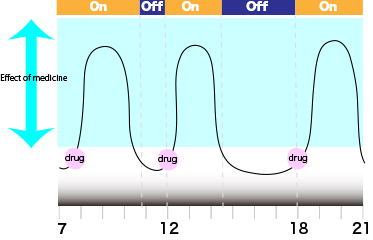- HOME
- For Patients
- Parkinson disease
- Timing of surgery
Parkinson disease
- About Parkinson disease
- Symptom of Parkinson disease
- Other symptoms of Parkinson's disease
- Cause of Parkinson disease
- Diagnosis of Parkinson disease
- Treatment of Parkinson disease
- Details of surgical treatment
- Surgical treatment of Parkinson disease
- Timing of surgery
- About our team
Timing of surgery
The chance to undergo brain surgery
Brain surgery (deep brain stimulation, or DBS) is usually considered during the period around 10 years after the onset of Parkinson's disease. In the experience of neurosurgeons who perform DBS, this intervention is less effective in raising the level of medication (or the "off" state) in patients over 70 years old, and many such patients are not entirely satisfied with the outcomes of surgery. For this reason, DBS is recommended for patients aged from their late 50s to their 60s.
The ideal outcome of DBS is liberation from drug treatment for a certain period, recovering one's former self as it was before the onset of Parkinson's disease, and this is the goal of the operation. Some patients who develop Parkinson's disease at a young age and who are offered the option of undergoing DBS at an early stage may be able to enjoy this happy period without requiring any medication at all. In the treatment of Parkinson's disease, patients become aware around 5 years after starting drug therapy that they have "on" times when medication is effective and "off" times when its effectiveness wears off.
People whose symptoms of Parkinson's disease appear when they are in their 50s are started off on drug therapy. A majority of such patients who later undergo surgery in their 60s experience an improvement during "off" times thanks to DBS. However, some patients say that they do not experience any improvement in symptoms they had hoped would become milder during "on" times as a result of DBS. Nevertheless, others report that some symptoms that are distressing during "off" times improve to a similar level to "on" times when they were taking medication. As you will probably have noticed, the terms "on" and "off" are still used even after undergoing DBS. That is, you should understand that even though many patients can successfully reduce the dose and number of types of medication they are taking, drug treatment is still required.
When treating Parkinson's disease, physicians tend to listen to patients' complaints that they are unable to move their bodies during "off" times. However, they tend to be less receptive to patients' complaints that their bodies will not stop moving by themselves, regarding this as better than not being able to move at all. In most cases, this state in which the body will not stop moving by itself is known as "dyskinesia", and is known to be associated with the medication used to treat Parkinson's disease. DBS may be carried out with the objective of reducing the severity of dyskinesia. Patients suffering from severe dyskinesia have reached the stage at which they have to take a large number of different medications, meaning that further treatment with drugs is problematic. As dyskinesia worsens, they become unable to sit still or even to eat, a situation that not only poses great hardship to patients themselves, but is also a huge burden on caregivers. DBS offers the possibility of reducing medications and can be expected to reduce the severity of dyskinesia.
The inclusion of DBS into the drug-centered treatment of Parkinson's disease may thus enable patients to deal more effectively with the natural course of their condition. DBS extends the period in which a patient can effectively live with this disease, while we can only hope that it will lead to the future development of new drugs and direct treatments for the underlying causes of this disorder.

It is important to remember that the progress of the disease and the effectiveness of treatments vary from patient to patient. Not all Parkinson's disease patients fit the descriptions given above. Please understand that this information is a simplified overview of the experience of a large number of patients in the past, and that progression of the disease will differ between patients.







